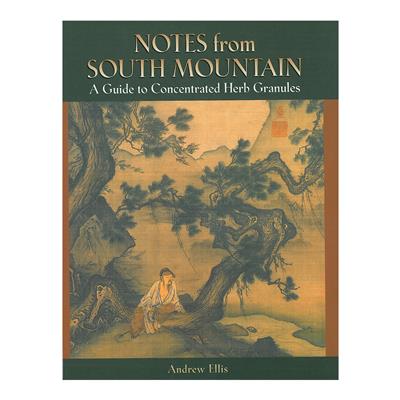Notes from South Mountain
Item No.
BKHM0014
Though in its early conception it was a simple product guide for a proprietary herb line, this work evolved to its current state as a result of the author's belief that the modern practitioner needs educational material that not only includes indications and functions of the formulas but that also
Read full description
Description
Though in its early conception it was a simple product guide for a proprietary herb line, this work evolved to its current state as a result of the author's belief that the modern practitioner needs educational material that not only includes indications and functions of the formulas but that also ties this information to the roots of Chinese medicine and the real world of the clinic. To that end, its purpose is to help students and practitioners see classical formulas not as archaic and static fossils of intellectual dogma but as living, changeable expressions of a natural philosophy. It is the author's hope that the deeper understanding of Chinese medicine gained from appreciation of the formulas' origins and evolution will help practitioners successfully treat the complex and varied patterns that present in their practices.
The introduction includes both a section on how to prescribe and dose herb concentrates, and a section that describes the production of herb concentrates. The main formula section of the text presents functions, indications, and ingredients for almost 300 formulas (arranged alphabetically according to pinyin name), and includes textbook-style discussion and modification sections. Each formula discussion focuses on how the formula is used in the clinic, based on the evolution of its use from the time of its source text to the present. The discussion and modifications sections include both classical and modern uses, and seek to show the relationship between the two. Where relevant, the formula under discussion is compared with similar formulas, and guidelines for determining the correct formula for a given situation are provided. The material in the discussion and modifications sections is drawn from the author's experience, the experience of the practitioners with whom he has studied, the source texts (when available to the author), and commentaries by modern authors. The book emphasizes clinical usage and is an ideal companion text to exhaustive formulary texts, in that it can give a slightly different perspective on formulas and supply additional information about clinical applications.
The introduction includes both a section on how to prescribe and dose herb concentrates, and a section that describes the production of herb concentrates. The main formula section of the text presents functions, indications, and ingredients for almost 300 formulas (arranged alphabetically according to pinyin name), and includes textbook-style discussion and modification sections. Each formula discussion focuses on how the formula is used in the clinic, based on the evolution of its use from the time of its source text to the present. The discussion and modifications sections include both classical and modern uses, and seek to show the relationship between the two. Where relevant, the formula under discussion is compared with similar formulas, and guidelines for determining the correct formula for a given situation are provided. The material in the discussion and modifications sections is drawn from the author's experience, the experience of the practitioners with whom he has studied, the source texts (when available to the author), and commentaries by modern authors. The book emphasizes clinical usage and is an ideal companion text to exhaustive formulary texts, in that it can give a slightly different perspective on formulas and supply additional information about clinical applications.
Specifications
| Name | Notes from South Mountain |



